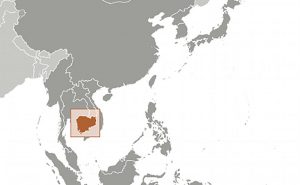Cambodia’s Knowledge-Based Economy: More Than BRI – Analysis
By RSIS
The Digital Silk Road component of China’s Belt and Road Initiative (BRI) provides Cambodia with an opportunity to advance on its path towards the knowledge-based economy. While both Cambodia and China can achieve a win-win situation, Phnom Penh’s position in ASEAN can also be strengthened.
By Prashanta Pradhan*
Earlier this year, Huawei, a leading Chinese telecommunication company, sealed a partnership with Malaysia’s Smart Axiata to launch 4.5G mobile connectivity in Cambodia. This will give ten times faster mobile Internet speed than normal 4G. This is just an example of China’s role and potential in Cambodia’s economic development. China contributed the highest share of invested capital (30%) and bilateral aid (36%) for Cambodia in 2016. In 2016 alone, total trade between Cambodia and China reached US$4.8 billion while Chinese investments in Cambodia amounted to more than US$5.1 billion. It is timely for Cambodia that the Digital Silk Road component of China’s Belt and Road Initiative (BRI) is gaining momentum.
Digital Silk Road

Cambodia is a fast growing developing economy. The country aims to boost its technological skill and infrastructure base on its path towards a knowledge-based economy as envisioned in Cambodia’s Industrial Development Policy (IDP) 2015-25. To realise this vision, the country needs to tap the bigger platform of economic opportunities on digital technologies and sustainable development under the Digital Silk Road.
Traditional physical infrastructure like roads and energy provides the foundation for trade and economic growth. But technology and innovation infrastructure provides the tools for Cambodia to take bigger leaps to advance towards a middle-income country. Negotiating more investment and aid under the Digital Silk Road shall enable Cambodia to employ the Internet of Things and Industry 4.0.
This can lead to opportunities including competitiveness enhancement, economic diversification, skill upgradation and deeper participation in regional and global value chains. During Prime Minister Hun Sen’s visit to China for the Belt and Road Summit in May 2017, China granted US$240 million in aid to Cambodia covering agreements
including telecommunication, marine environment monitoring and other physical infrastructure.
Telecommunications
While Cambodia has achieved good results in the telecommunication industry, opportunities are still available in upgrading the backbone and enhancing countrywide access. This is highly relevant in light of recent developments on Cambodia signing the cross-border paperless trade facilitation agreement, inclination towards
advanced manufacturing, promotion of e-governance, expansion of fintech businesses, increasing interest in launching satellite and implementing smart cities initiative. Developing ICT infrastructure is a priority area under Cambodia’s ICT Master Plan 2020. It is worth noting that at least two leading Chinese companies, Huawei and ZTE, already have active presence in the telecommunication sector in Cambodia. They plan to be major players in China’s BRI projects abroad. The telecommunication business in Cambodia is relatively limited unless the companies in Cambodia are able to penetrate the market of the Greater Mekong Sub-region (GMS).
In this respect, those firms operating out of Cambodia will face stiff competition from their Vietnamese and Thai counterparts. One way is for Huawei and ZTE as well as Smart Axiata to design their future expansion in Cambodia through joint ventures with associated companies in mainland Southeast Asia.
For Cambodian engineering and technology-based firms, their development and survival will depend on the ability to serve as partners or sub-contractors with the bigger and leading foreign companies as they move into local markets to develop telecommunication infrastructure under investment cooperation in the Chinese BRI framework.
Scientific Cooperation and Sustainable Development
Cambodia’s path towards becoming a knowledge-based economy begins with development of the skills base for technology and knowledge-based industries. Enhancing R&D capability is a priority under Cambodia’s National Science and Technology Master Plan 2014-2020 and IDP.
Given the priorities of the Cambodian government, China’s planned Belt and Road Science, Technology and Innovation Cooperation Action Plan is very pertinent. This plan will consist of providing short-term visits to 2,500 young scientists, train 5,000 foreign scientists, engineers and managers as well as set up 50 joint laboratories in
the next five years.
Cambodia harbours a diverse base of natural resources given its geographical position in the GMS. It is necessary to implement policies to accelerate educational and skills development, and to orientate Cambodia’s participation in ASEAN economic and socio-cultural cooperation to create a broad and sustainable foundation for Cambodia’s knowledge-based future.
Risk Management
While there is potential for numerous opportunities under the BRI framework, Cambodia should also properly understand potential risks and devise strategies to manage them.
Information Security
Information security concerns from using foreign-built telecommunication infrastructure is not new. However, in a changing geopolitical scenario of increasing number of countries developing economic, political and military ties with China, the question is whether Cambodia should let these concerns deprive itself of economic
opportunities.
One way to go forward is to enhance the capacity of local authorities to monitor the technical processes of project management as well as negotiate proper terms with their counterparts and businesses in China when projects are being mooted. Examples could include limiting equipment manufacturers’ access to sensitive data, ensuring ownership of patent rights and requiring transparency.
Environmental, Social and Governance (ESG) considerations
ESG considerations are often raised when discussing Chinese investments in developing countries. Nevertheless, Chinese investments also allow much flexibility to national governments. Hence, rather than resisting investments, an approach to enhance ESG compliance can be ensured through institutionalising proper frameworks.
Moreover, there should be due diligence mechanisms within the national systems to conduct proper feasibility and commercial viability assessments of infrastructure projects. The ongoing collaboration of multilateral development agencies with China on sustainable development issues can be extended to build institutional and oversight capacities in developing countries.
Win-win Situation
China launched BRI in 2013 to support the development of trade and infrastructure network in partner countries (currently 68) ranging from Europe along Central Asia through Southeast Asia into the Indian Ocean and beyond. Such a mega project serves China’s national interests.
Firstly, it allows exporting China’s surplus productive capacity to sustain prosperity at home. Secondly, it enables China to establish strategic geopolitical influence in specific regions and states through soft power. Cambodia must identify areas most beneficial to its own interests and capitalise on suitable opportunities.
While meeting Cambodia’s development goals, strengthening the country’s position in ASEAN — Southeast Asia’s only regional organisation — must also rank as an important objective. Technological advances will raise Cambodia’s development status and give it a stronger voice in ASEAN and beyond. In turn, this will help accelerate Cambodia’s development and progress.
*Prashanta Pradhan is a trade and investment policy specialist advising development agencies and governments, currently, based in Phnom Penh, Cambodia. He holds a Master’s degree in Public Policy from the Lee Kuan Yew School of Public Policy, National University of Singapore. He contributed this to RSIS Commentary.

